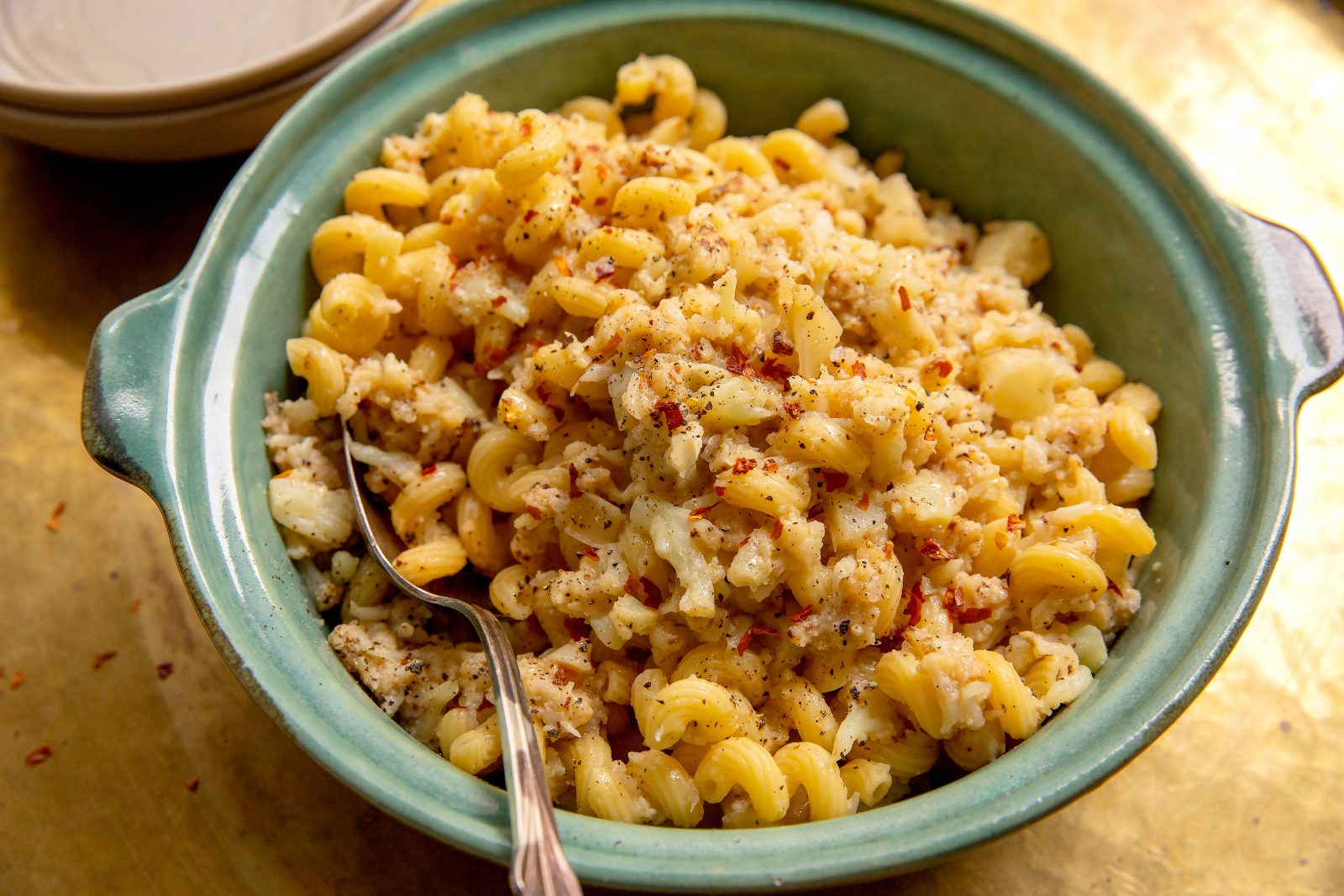Your email address is required to begin the subscription process. We will use it for customer service and other communications from Milk Street. You can unsubscribe from receiving our emails at any time.

Two-Cheese Pasta with Cauliflower
We learned this recipe from home cook Antonella Scala in Naples. We loved how it uses the same water to both parcook the cauliflower and to cook the pasta. Parcooking means the cauliflower browns quickly when it is later added to the skillet. It also enriches the water, infusing the pasta with some of the vegetable's flavor. To contrast the cauliflower's subtle sweetness, we like equal amounts of salty, savory pecorino Romano cheese and aged provolone (also called provolone picante, or sharp provolone). If you can't find aged provolone, regular provolone is an acceptable, though milder, substitute. Short, twisty pasta shapes such as campanelle and cavatappi combine perfectly with the cauliflower florets. We boil the pasta for only 5 minutes (it will be well shy of al dente), then finish cooking it directly in the skillet with the cauliflower.
4
Servings
Don't forget to reserve 2½ cups of the cooking water before you drain the pasta. You'll need it for simmering the cauliflower and for creating the sauce. Also, don't add the grated cheeses all at once. Sprinkling each one over the surface of the pasta and stirring before sprinkling on more prevents the cheese from clumping.
40 minutes
Ingredients
-
Kosher salt and ground black pepper
-
2
pound head cauliflower, halved and trimmed of leaves
Directions
-
01In a large pot, bring 4 quarts water to a boil. Add 1 tablespoons salt and the cauliflower halves and cook for 5 minutes; begin timing from the moment the cauliflower is added to the pot. Using tongs, transfer the cauliflower to a cutting board; reserve the pot and the water. When the cauliflower is cool enough to handle, chop the florets and stems into pieces slightly smaller than the pasta, discarding the thick, tough core. You should have about 4 cups. Return the water to a boil.
Pardon the interruption
You need to be a Milk Street Digital Member to see the full recipe
JOIN MILK STREET DIGITAL & PRINT
12 WEEKS FOR JUST $1
and get access to all of our recipes and articles online, as well as in print.
GET DIGITAL & PRINTThis was good, easy, quick, but I didn't get the creamy consistency I assume was intended. The cheese congealed somewhat. Was it too hot? Not wet enough? I added more water and there was water in the bottom of the pan, and I tossed it and tossed it to try and get the pasta water to blend with the cheese. I don't know, it was good but I'm not sure it was a success.
I made this and really liked the taste and flavor. Excellent concept for using cauliflower, and very nice mix of cheeses. But I had to use the entire 1 1/2 cups of pasta water, and then some, to get the pasta to be edible, and by the time it reached that state, the cauliflower had pretty much disintegrated and the mixture looked sort of mushy. I think you need to get the pasta closer to al dente before you remove it from the water -- probably 7-8 minutes instead of 5. And I might try adding peas at the end, just to give the dish a splash of color and a bit more texture.
This was surprisingly good! I initially wanted to make it because the picture looked so good. I'm a big fan of the cavatappi pasta shape, so it was probably that. I bought all the ingredients, but then I procrastinated making the dish because I wasn't sure the cauliflower was going to go well with the pasta and because, honestly, I knew that aged provolone was a stinky cheese and I was afraid that I wouldn't like the flavor.
Well, after a few days of reminding me, my husband took the recipe and made it himself. And yeah, the provolone *was* stinky, but it didn't taste the way it smelled :) The cauliflower was delicious in the pasta, and we will definitely be making this again!
I am always amused at comments: Maureen doesn’t like aged Gouda, the recipe doesn’t call for it, Lee said it didn’t work with 1-1/2 cups of water, the recipe calls for 2-1/2. You at Milk Street must be blessed with good senses of humor.
That said, I would agree with Lee, it needed more water to cook the pasta once in the pan with the cauliflower. I didn’t add the pasta after 5 minutes but closer to 8 and it still was a bit more toothsome than we liked. It may have been the shape or the age of the pasta but I would suggest testing the pasta before draining it and adding to cauliflower. But the cheeses melted beautifully for a creamy sauce, it was a bit spicy which we enjoyed. The cauliflower was tender but with a yummy char. A keeper for certain!


Thank you for your comment! Your comment is currently under moderation and will appear shortly.